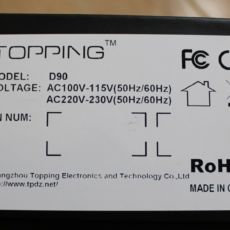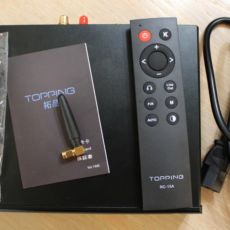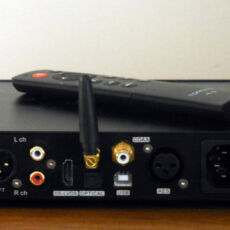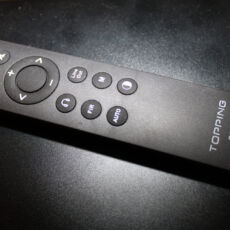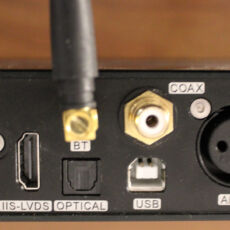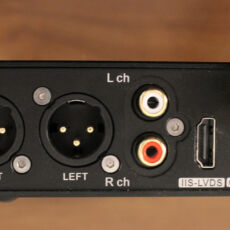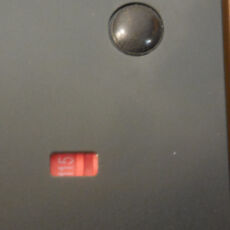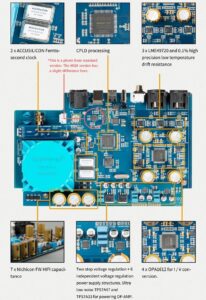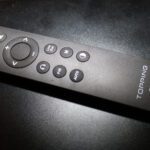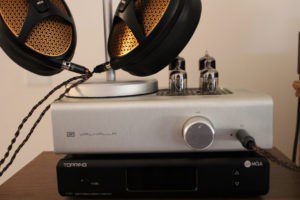Topping D90 MQA
Disclaimer: Apos Audio sent the D90 MQA for review as a loaner. I have no financial interest in Apos Audio, or Topping, and received no compensation for this review. I am using an affiliate link here at the request of Apos Audio for tracking purposes, but do not claim proceeds from the use of this link. Increasingly vendors are requesting use of affiliate links so you may see more of them added to my reviews for tracking purposes, rest assured I have no intention of monetizing this site. For more information about the D90, see Apos Audio, or Topping’s website.
Unbox/Packaging:
Those familiar with topping products will recognize the packaging of the D90 as it follows the trend with a matte black box with the Topping name on top. Details of what is in the box are provided by a label on the side. Lifting the top reveals the DAC tucked into a foam surround protected by a plastic bag with compartments cut in the foam for the accessories A little more unpacking and you have the USB cable, power cable, bluetooth antenna, and remote unpacked. The addition of a set of RCA cables so you don’t have to go dig for them would be appreciated but otherwise it is a fairly complete kit. One thing to note, the 110/230V switch is on the bottom of the unit and should be set to the appropriate value before plugging the unit in.
Build:
The unit itself is as understated as the packaging with the front of the unit from left to right having the power button, display screen, and up/down buttons. The only difference here between the original D90 and the current revision is the MQA Logo in the upper right corner. The Frame is all anodized aluminum with no plastic parts save the bluetooth antenna. I previously mentioned the Voltage switch on the under-side of the unit which was likely placed there as the rear face is already a bit busy. From left to Right, the rear of the unit has a pair of XLR outputs followed by the RCA outs. The next block is the inputs starting with an HDMI style IIS input, then an optical (Toslink) and the blutooth antenna port stacked one on top of the other, coax and USB are similarly stacked next in line followed by single XLR for AES input. The last block is the power input which has a standard C13 female port with fusing built in and the power switch. For a unit less than 9 inches long, it packs a lot of options into a small footprint for sure. Overall heft of the unit is gratifying as well as it feels very solid in hand with no rattle, lose ports, or wobble to any of the sockets. It looks equally at home in my headphone setup or replacing my Bel Canto in my home setup. Props to Topping for looking the part of a high end unit, now about that remote…. (Unfortunately, the remote is the universal topping remote and not a dedicated unit that a flagship deserves which is a bit of let down as it is plastic, some buttons do nothing, and generally not up to the level of the unit itself. The remote works, it just isn’t on the same build level as the unit.)
Internals:
There is a lot going on inside this small box. I had originally thought I’d pull the board and take some internals shots but that proved to be fairly difficult and with this being a loaner, I didn’t want to risk damage to the unit so I quickly gave up on the internals photos. The biggest upgrade from the original D90 that was already pretty well spec’d is an upgrade to the USB input which is now an Xmos 216 instead of the original 208. This facilitates full MQA decode which is only available via the USB interface. An AK4118 receiver handles the Coax, Optical, AES, and bluetooth inputs and thus MQA is not available through those channels as the 4118 is not MQA capable. IIS hits a middle ground as it is handled seperately and supports DSD which coax does not, but stops short of supporting MQA. Once the signal is received by either the Xmos216 or the AK4118, it is passed to an AK 4499 DAC chip to handle the conversion duties. A pair of femto-clocks are used for timing, and 4 OPA1612 handle I/V conversion. Three LME49720 Op-amps round out the signal paths with both single ended and balanced outputs supported. All of this is controlled by a micro-processor. Topping advertises this as CPLD processing which is Complex Programmable Logic Device, a big word for micro-processor. Outputs are either a volume-controlled pre-amp mode or a pure DAC Mode with fixed 2Volt output for single ended and 4Volt output for XLR.
Inputs:
supported bit rates and sample frequencies vary depending on input used:
USB Supports: 16-32 bits at 44.1-768kHz for PCM, 64-512 DSD Native, Full MQA Unfolding (Note that all of these require the use of the Thesycon drivers for full support)
Coax/Optical/AES inputs support: 16-24bit at 44.1-192kHz and are PCM only
IIS supports 16-32 bits at 44.1-768kHz PCM and DSD from 64-512. MQA is not supported.
Bluetooth Protocols include: SBC, AAC, AptX (including LL and HD), and LDAC
Settings:
The D90 is designed to be controlled using the remote as the single button on the front of the unit serves as on off and input select, but all other functions require the use of the remote to access. Down the left side of the remote, you have Power, a headphone button that is not used, the FIR Filter select button, and the Auto button which turns on and off automatic standby. Filters available are Sharp, slow, short-delay sharp, short-delay slow, super slow, and low dispersion short-delay when using PCM input and 37kHz or 65kHz when using DSD input. IIS and DSD phase settings can also be adjusted. The Auto-standby feature allows the device to go to sleep when no signal is detected and power back up on signal introduction. For the most part I found this worked well but did occasionally clip the first note while waking up. Down the right side of the remote we have mute at the top, display brightness at the bottom, and two unused buttons between. On the wheel in the remotes center, up and down are volume control in pre-amp mode, while right and left are input selection and the center of the wheel controls output selection. Pairing bluetooth is enabled by holding down the Brightness button until the display indicates pairing. The unit must be in bluetooth mode before holding down the button as it will not initiate bluetooth mode if the unit is not already in it.
Sound:
Sound discussions of DACs are hard. In a perfect world, they would be unnecessary as the conversion between digital and analog would be 100% accurate, and the other components wouldn’t influence the output. Those who believe this is achievable probably qualify as obsessed and in need of treatment although many of us keep searching. For sake of this review, I decided to try the D90 in both my home system as replacement for my Bel Canto 2.7 and in my headphone rigs replacing either my RME ADI-2, the Burson Swing, or a Bifrost MB as these units do a good job of representing the competition the D90 will face in the wild. Admittedly the Bel Canto and RME units are a good bit more costly and it probably isn’t quite fair to expect the same level of performance out of the D90, but with it carrying flagship credentials it seems a bit more of a fair fight.
My home rig has some parts that seem to change frequently and others that don’t. The constants are my Levinson 23 amp and my Magnepan 3.7s. Pre-amps and DACs have been changed out several times along the way either to garner more inputs, better sound, remote control etc. Currently the DAC duties are being handled by a Bel Canto 2.7 while the pre-amp slot has a couple of different options being auditioned. Typically I have been using an Emotiva here but wanted something a bit warmer so have been auditioning a Triode TRX-1 using some NOS 5751 tubes (no balanced input or output though so probably not going to stay) and a loaner PrimaLuna EVO-400 (which SWMBO will eventually kill me for buying when I do) to introduce a little warmth into an otherwise very clinical sounding chain of devices. Trading the D90 into the Bel Canto spot using a fully balanced chain makes remarkably little difference. Both are very clean, detailed, and crisp. Those looking for a more fluid presentation because of the AK chip at the core will be disappointed as the D90 has a distinctly technical voice to it and if I hadn’t known which chip was inside at the outset I’d have bet Saber. If the D90 gives up anything to the BC, it is a slight bit of fluidity that is particularly on display in the lower treble. Honestly, I could be very satisfied with the D90 in place of the Bel Canto in this rig. It did equally well unbalanced running through the TRX-1 and was a bit warmer and thicker in tone here due to the tubes in use in the pre-amp. The good news is the sound does take on the character of the chain so this pairing will be good for those that find the d90 a bit too clinical leaning when paired with a high precision amp.
Replacing the ADI-2 in my headphone rig was a bit less successful as here the D90 doesn’t have quite the chops of the ADI-2. Again, not entirely unexpected since the ADI-2 is three times the price of the D90. The ADI is more detailed and a touch cleaner than the D90 while the D90 is a little more rounded off and smoother. Transients are faster on the ADI-2 and that probably accounts for most of the differences. Had I not listened to the ADI-2 for nearly 6 months now, I’d have probably found fewer differences as they are small, but they are present. Do I think the D90 represents 1/3rd the value of the ADI-2, absolutely not. The unit delivers 90-95% of the ADI-2’s capabilities for 1/3rd the price, it represents a tremendous value in that respect.
Likewise when I replaced my Burson swing (modified with SparkOS Op-amps throughout) , I could tell some minor differences between the D90 and the Swing. Here the transients were faster on the swing and it sounded a bit cleaner while the D90 was a little fuller in the mids and lacked just a touch of air at the very top. Again, with the Swing and modifications pushing it to nearly double the price of the D90 and the Swing not supporting MQA, I find the D90 a great value and close enough in sound that one has to go looking for the differences to find them.
Lastly the Bifrost MB/Valhalla combo – here we see the biggest difference in the units. The bimby presents a thicker, richer tone, but smooths off some of the details compared to the D90. By comparison the D90 sounds a bit lean, not thin, but lean. The Bifrost will please those more interested in musicality than technical correctness while the D90 makes a better starting point for those looking for reference style sound. Again, I don’t think the difference in sound here is a knock on either product, just they are designed to satisfy two different consumers with the Bifrost being more forgiving of poor source and the D90 being more accurate and true to what was fed it.
Conclusions:
Topping has been making a name for itself with a string of dacs and dac/amps that test remarkably well, pack a lot of features, and are extremely competitively priced. The D90MQA continues that trend and again represents value beyond its asking price. I can honestly say if I had to test blind, I likely would have had trouble picking out differences between the Bel Canto, the D90, and even the RME as all are within striking distance of each other. The Bimby is enough different to be easily picked out, but aims for a bit different tuning and is not so much a matter of better or worse as it is end user preference. For me, I could live happily with the D90 in place of the Bel Canto in my home system, I could easily replace the Bifrost with it and never miss a beat, and even the RME ADI-2 is only marginally better at a considerably higher price. The Burson Swing comes closer in both price and performance but with most choosing to upgrade the op-amps in the Burson, the price point quickly moves away from that of the D90. Those looking for a reference tuned dac with great features at a budget price tag would do well to consider the D90MQa. It gets an easy recommendation from me as it outperforms most of what I have heard at anywhere near its price point (Unless those devices also say Topping on the front). Thanks again to Apos Audio for the use of this unit to review.
-
Packaging - 7/107/10
-
Accessories - 7.5/107.5/10
-
Build Quality - 8/108/10
-
Input Flexibilty - 8/108/10
-
sound quality - 8/108/10
Summary
Pros: Great build quality, near reference sound, good input and output options.
Cons: universal remote not of same quality as main unit, some controls a bit clunky to manipulate.


